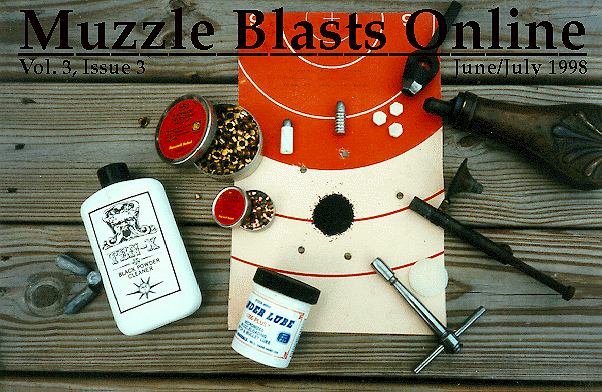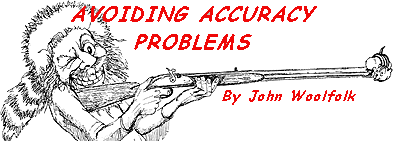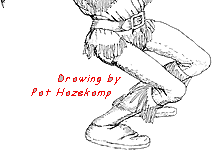|
Muzzle Blasts Online |
|
...for the muzzleloading enthusiast |
|
The muzzleblasts.com domain, subdomains, content, etc., are neither affiliated with the NMLRA nor its paper magazine Muzzle Blasts |
|
Muzzle Blasts Online |

|
|
|
|
|
|

|

|
|
|
I stepped aside to let the other shooters in my group take their turns and traced in my memory just what I had been doing prior to that last shot. I had gotten into a conversation with a fellow whom I had met a year or so ago at another rendezvous. My loading technique is almost automatic after all these years; but had I become distracted and left something out? I pulled a cleaning patch from my pouch, wet it with saliva, and ran it down the bore. Yup! There was the culprit. Just ahead of the place where the ball seats was a ring of fouling. When I had "firmly seated" the ball, I had done so on the ring of fouling--not on the powder. That's why it's important to pay attention to your loading procedure and check the pencil mark on your ramrod that indicates that the bullet is seated properly. Uncompressed black powder burns dirty and does not give the same velocity as a compressed load. I was shooting out of a bullet block using patches lubed with one of the new super-duper lubes which "eliminate the need for wiping between shots." I had tried it out a week previous and had put ten shots, without wiping, into a two-inch group, offhand, at fifty yards. But the weather then had been cool and drizzly, and the humidity was about 95%. This day was warm and sunny, and the humidity was low--just the ticket for building up fouling, and super-goop or no, it built up. A couple of wet patches and a dry one went down the bore. The next shot was at a vertical chain at about the same range as the big square. The hold felt good, the follow through was steady, and the chain jumped as the ball hit it.
Now, if you are an old hivernant and never wipe between shots, I am not going to tell you that you simply must do it. I am simply passing on a few thoughts which I have come up with in nearly a half-century of futzing about with black powder. However, it is undoubtedly safer to wipe, and just as I did, you will someday run into a problem if you don't. It is not at all unusual, on a trailwalk, for one miss to be the difference between a first-three-places position and a seat down among the also-shots. Few misses and a good tie-breaker are de rigueur for winning, and that's not compatible with a fouled bore.
Speaking of fouling, it is high fashion today to clean your bore with a mixture of oil soap, alcohol and peroxide. Let me issue a caveat about this practice. While this mixture cleans the bore extremely well, it also presents some problems which its advocates seldom mention. First of all, it is not water-free, as some folks claim. If you use rubbing alcohol, it can be up to 20% water quite legally. The hydrogen peroxide which you buy in the drugstore is normally a 3% solution. This means that if you make up a solution using a cup each of oil soap, peroxide, and rubbing alcohol, you have 24 ounces, about 9 1/3 of which are water (39%). This is not bad, just not as often advertised. The problem is the peroxide. Notice how it bubbles as it works. It is getting right down into those microscopic cracks in your barrel and cleaning them out. The effect is much like using soap to clean a cast-iron skillet. The result is bare, unseasoned metal, open to the moist air, resulting in rust. If you use this stuff, beware. While it cleans well, it also sets you up for rust problems, so you need to take action accordingly. Rust in a bore is not conducive to accuracy.
On many a rifle trail, the first shot is the tie-breaker. If you shoot with a clean bore, you may find that the first shot goes other than where you aimed--especially if you use oil or grease in your rifle. I prefer "Breakfree" or Amway's "Wondermist". There are a number of other silicon lubes which work well and do not leave ignition-slowing, accuracy-affecting residues in your bore. It is always a good idea to "foul" your bore. If you do so, I might suggest that you not "foof" it: don't put down some powder and shoot it out without a ball. This does not create enough pressure to burn the powder cleanly. You end up with gunk in your barrel, and that might well cause as many problems as it eliminates. Load up normally and shoot at a wood chip, a pine cone, or some other target in a safe place on the hillside. Get in a practice shot and, at the same time, properly burn the lubricants out of your barrel. Now swab and load. Your odds of quick ignition and a true shot will be considerably improved. (I must admit that when I do this, it is not at all uncommon for that first shot to go right where I aimed it and the second to go "galley west." But that is my fault, not the load's or the gun's.)
A few years ago, a friend sent me a container of Elephant Brand 5f priming powder to try. At that time it was not yet on the market. I fear I did not make him happy by telling him that I didn't care for it. In humid weather, it tends to pack like powdered sugar, and it was a pain to try to get it to come out of the little orifice in my priming horn. Since then, I have started mixing it 50/50 with 4f. It flows well and my ignition is FAST. If your flint ignition is not as fast as you think it should be, you might give this a try. Just remember to invert your priming horn from time to time and give it a few shakes so that the 4f does not migrate to the upper end. If you start to have problems with powder flow, this is the probable cause, and it is remedied with a few shakes. An even mixture is not necessary for good ignition.
If I simply step up and shoot, I will score poorly. If I take the time to establish control over mind and body, I will do well. I find that a moment or two to position my feet, so that I can stand firmly, is time well spent. I then drop my arms, holding my rifle, and make a conscious effort to relax as I breathe deeply. Usually, I can feel a quiver run through my body as it loosens up. If you have a "medicine bead" hanging from your trigger guard, stroke it. This simple action helps to blot out distractions. I bring the rifle to full cock as I raise it, eyes on the target. The rifle should settle in naturally and line up quickly. If it doesn't, you may have a poorly-fitting rifle. This can give you all kinds of problems. As soon as you are lined up, start your squeeze. If you wait too long, trying for better alignment, you will start to quiver. If that happens, lower your rifle, regain control, and start over. Don't worry about the other shooters. Too many people miss shots by rushing them because they are worried about others getting impatient. Unless you are repeatedly taking an excessive amount of time shooting, nobody is going to be bothered. "Haste maketh waste."
Big "gimme" clangers are often the nemeses of many shooters (including me!). When you are shooting at a hanging chain, especially one big enough to shoot right through a link, your discipline is exquisite. But when the target is a big old circular saw blade about four feet in diameter and no more than 100 yards away, it is easy to get sloppy and just aim at the whole target in general...and miss. With these big "easy" targets, pick a spot on the thing and shoot to hit that and that only. Then you will be certain of a hit. (Well, almost certain). At one rendezvous, I taped up the three-inch mandrel hole in the center of a 48-inch circular saw blade hung at 150 yards. When the shoot was over, I checked it. There were three holes in the tape. Sometimes a person can shoot too well.
On a trail walk, almost all the shooting is done offhand. Shooting from a bench, for anything except sighting in and load development, is a waste of time. In my neck of the woods, most deer and elk are shot offhand. Yet when one goes to the range on an open-shooting day, you find most folks shooting from the bench. Learn to shoot from your hind legs. You are not allowed to take a bench on the trail, and a bench is too clumsy to carry in the woods.
Another thought to ponder: Many rifles, especially those with long 13/16" inch barrels, do not shoot to the same point from a bench as they do offhand. Make sure that you lay your hand across the sandbag and hold the fore end in your hand. A friend sighted in a new barrel from the bench and then found that it shot way too low offhand. After filing the front sight to get the group up where it belonged, he discovered that it was so low that he got heat mirage off of the barrel after a couple of shots. A new sight was the only answer and a sighting session...offhand.
"Magnumitis" is a problem that plagues many new shooters, and some older ones. Put simply, this is a case of too ding-busted much powder. At one of our club shoots, we had a fellow who was missing with great regularity and busting everyone's ear drums with each shot. After several people suggested that he would do a lot better with a lighter load in his rifle, he dropped from 100 grains of 2f in his .50 caliber to 70 grains. He started hitting almost immediately, and with a little practice to get rid of his flinches, he became a rather good shot. You only need to hit the clangers. You get no bonus points by turning them into fortune cookies.
However, here's another caveat. While lighter loads mean less fouling, as do loads of faster burning powder, there is a dragon waiting in the bushes for the unwary. Many people reason that a light load of 3f powder, which will give the same velocity with less fouling as a heavier weight of 2f, is also the way to go in the bigger bores. Out to 75 yards, I use 35 grains of 3fg in my .40 caliber flinter. This gives me about 1460 fps. To get this same velocity with 2fg would take about 42 grains. Sure, 2f would give me less pressure, but we are only talking about approximately 4,800 lup in the 3f load--hardly enough to worry about, and the 3f burns much cleaner. If you consider a thousand shots good barrel life, go for the fast powder. If you think that a barrel should last for many thousands of shots, go for the slower powder and clean a bit more often. Personally, I opt for the longer barrel life and added safety, minor though it may be, provided by 2f in 50 caliber and above.
If you are fairly new to muzzleloading, your accuracy problems may not lie primarily with you or your rifle's inherent accuracy. It may be a case of incompatibility. All of the pseudo-Hawkens and modern style in-line rifles I have seen are designed with combs that are far more compatible with a scope sight than with iron sights. Scrunching your face down enough to see though the open sights required in primitive shoots sets you up for a smacked cheek. A few of these and you have an accuracy-destroying flinch. Also, most modern muzzleloaders balance more like shotguns and are not, in contrast to traditional rifles, designed for off-hand shooting. They are great from a bench, prone, sitting, or from a blind. The way I hunt, about 95% of my shots at game are offhand. Naturally, I prefer a traditional-style rifle. Make sure that your rifle, whatever the type, fits you and your sport.
One last comment on something which can affect accuracy, even though it has nothing to do with your rifle's ability to lay them in there: the buttplate. While the American rifle started out with a fairly flat butt, throughout the 18th and 19th centuries most rifles had crescent buttplates. Everyone "knew" that you shot your rifle with the butt snugged onto your upper arm. The crescent curved around the big muscle of the arm and recoil was absorbed by a combination of shoulder and arm movement. The crescent buttplate was especially popular in squirrel hunting country because shooting off of the arm keeps the butt from smacking you downward on the clavicle when firing at a high angle. Then came World War I. People who had never shot a rifle before going into the service came home with experience using the '03 Springfield and 1917. Enfield with their flat butts. When they picked up an old rifle with a crescent butt, they tried to shoot it the same way. It should come as no surprise that the points of the crescent cut into their shoulders. You cannot shoot well if you keep poking holes in your flesh with every shot. Make sure that you are using your rifle correctly. If you have a buttplate with a pronounced crescent, shoot it off of your upper arm. A flat butt should be snuggled into the trough formed between your shoulder and rib cage. Mildly curved crescents can be shot in the same manner as a flat butt and have the advantage of not tending to slip just as you pull the trigger. Whatever kind of rifle you have, shoot it in the manner which works best for you. However, if it is hurting you or you are getting unexplained misses, odds are you are doing something wrong.
Hopefully, you found in this article an idea or two which may help you on the road to success. Even if you are fairly new to muzzleloading, you have probably found by now that "going back to the basics" does not mean that you have simplified your life. When you shoot old-timely guns, you tend to re-discover problems that other shooter no longer face. Some of those problems are common; others are a real puzzlement. I hope this treatise has helped some folks overcome one or two of their bugaboos. Good shooting!